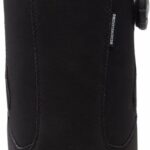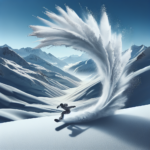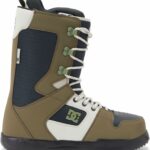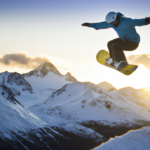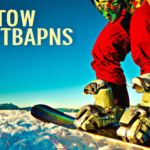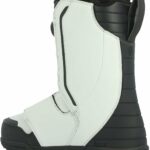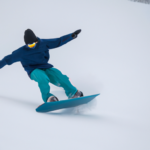Imagine you, gliding effortlessly down the mountain, the wind whipping past your face as you command your snowboard with skill and precision. Your heart pounds with adrenaline as you pick up speed, every curve and dip speaking directly to your adventurous spirit. In this article, “How To Go Faster On A Snowboard?” you’ll discover ways to master your board like a pro and learn techniques that will boost your speed and enhance your overall snowboarding experience.
Understanding Snowboard Design
Snowboarding is an exciting sport, but to master it, you need to understand every aspect of the equipment you use. And the most basic equipment is, of course, the snowboard itself. To get the most out of your snowboard, you need to understand its design elements.
Knowing the Parts of a Snowboard
The long piece of material that constitutes the main part of your snowboard is known as the deck. It’s where your boots are mounted and where you stand when you’re snowboarding. The deck has two ends: the nose (front) and the tail (back). The area where you mount your feet is the bindings. Meanwhile, the base of the snowboard is the part that contacts the snow. It’s essential to learn these parts because each plays a role in steering, control, and yes – speed!
Differentiating Between Snowboard Types
There are various types of snowboards out there, each with its specific design and intended purpose. Freestyle boards are light, short, and designed for tricks, while freeride boards are longer and intended for off-piste snowboarding. All-mountain boards, as the name suggests, can handle anything you throw at them. If speed is what you’re after, you’ll want to consider a carving or alpine board. These boards are longer, narrower, and great for fast downhill rides.
Choosing the Right Snowboard for Speed
Not all snowboards are created equal when it comes to speed. If you’re after an adrenaline rush, you need a snowboard designed for speed. Fast boards usually have a stiffer flex and are more extended, providing more stability while racing downhill. The base also plays an integral part – a well maintained and waxed sintered base will allow you to ride faster than an extruded one.
Proper Physical Preparation
Sure, you’ve chosen the perfect board, but are you physically fit to use it to its fullest potential? Your physical condition plays a crucial role in your ability to snowboard at high speeds.
Focusing on Overall Physical Fitness
Snowboarding requires a good level of overall physical fitness. You need to have cardiovascular endurance, muscle strength, and flexibility to perform well on the slopes, and especially to achieve higher speeds. Regular workouts, including running, biking, or swimming, can build your endurance while strength training can prepare your muscles for the rigors of snowboarding.
Strengthening Key Muscle Groups for Snowboarding
Certain muscles are used more in snowboarding than others. Focusing on strengthening your core, legs, and back can significantly improve your snowboarding ability. Squats, lunges, and planks are your friends here, as they target the key muscle groups used when snowboarding.
Flexibility Exercises for Snowboarders
Flexibility is often overlooked, but it’s just as essential, particularly when trying to increase your speeds on the board. The more flexible you are, the less likely you are to get injured and the better you’ll be able to handle your snowboard. Regular stretching, yoga, or Pilates can do wonders for improving flexibility.
Practicing Basic Snowboarding Techniques
Before you think about speed, you need to perfect your basic snowboarding techniques.
Perfecting Snowboarding Stance
Everything starts with your stance. You need a balanced and stable stance to control your snowboard. Your feet should be hip-width apart, your knees slightly bent, and your body weight evenly distributed over both feet.
Mastering Edging Techniques
Being able to use the board’s edges effectively is key to controlling your speed. The edge is the snowboard part that cuts into the snow to turn, slow down, or stop. Practice shifting your weight from one edge to the other and controlling your turns to get comfortable with edging techniques.
Learning How to Carve Properly
Carving is a type of turn that’s essential for high-speed snowboarding. You need to use the edges of your snowboard to cut into the snow and make a shaped turn. Carving turns are sharper and faster than basic turns, and they provide the control required when snowboarding at high speeds.
Intermediate Skills for Faster Snowboarding
Once you have the basics down, it’s time to take it up a notch and start working on the skills needed for faster snowboarding.
Implementing Dynamic Turns
Dynamic turns involve bending and stretching your legs to apply pressure at different points on the turn. This technique enables you to turn quickly and maintain more speed compared to standard turns.
Practicing Tuck Position for Speed
Your posture can significantly impact your speed. To go faster, practice the tuck position: bend your knees, lower your body towards the board, and keep your hands forward to reduce wind resistance. The tuck position helps you maintain more speed downhill.
Utilizing Jump Turns and Hop Turns
When you’re snowboarding at higher speeds, standard turns may not be enough. Jump and hop turns come in handy when you need to make a quick change in direction. They involve launching the snowboard off the snow briefly to snap it around faster.
Adapting to Snow Conditions
No two snow conditions are the same. Understanding how to adapt to these changes can make a huge difference in your speed.
Reading and Adapting to Snow Type
Snow can be powdery, icy, or slushy, and each type affects your speed in different ways. Learning to read the terrain and snow types, and adapt your techniques to tackle them effectively, can significantly enhance your speed.
Understanding Impact of Weather on Speed
The weather conditions can have a huge impact on your snowboarding experience. Cold, dry climates provide the fastest conditions as the snow is usually firmer. Conversely, wet snow caused by warmer weather or fresh snowfall can slow you down.
Adjusting Techniques for Different Snow Conditions
To maintain speed, you’ll need to adjust your techniques based on the snow conditions. You may have to lean back and flatten out your board on powder or lean further forward and dig your edges in on icy surfaces.
Snowboard Equipment Checks
If you want maximum speed, don’t ignore the role of equipment maintenance.
Maintaining Your Snowboard for Optimum Speed
Like a car that needs regular servicing, your snowboard needs maintenance to keep it running optimally. Keep an eye out for any damage and fix it promptly. Regularly cleaning and waxing your snowboard’s base can significantly improve your speed.
Choosing and Applying Snowboard Wax Correctly
The right wax can reduce friction between your board and the snow, thereby increasing your speed. Make sure you’re using appropriate wax for the day’s snow conditions. Additionally, ensure the wax is properly applied and buffed.
Importance of Properly Fitted Boots
Snowboard boots should be snug but comfortable. Ill-fitted boots won’t just make your ride uncomfortable; they will also lessen your control over the snowboard, reducing your speed. Invest in boots that fit your feet and the bindings on your board properly.
Mental Preparation and Safety
While physical fitness and skills are vital for speed snowboarding, don’t undervalue mental fitness and safety.
Overcoming Fear of Speed
Understandably, snowboarding at high speeds can be daunting. Gaining confidence comes with time, practice, and mental prep. Visualize success, work on controlled breathing, and gradually push your speed boundaries as you grow more comfortable.
Importance of Concentration in Snowboarding
Snowboarding demands acute focus. You need to pay attention to the terrain, your movements, and other riders as you thunder down the slopes. As speed increases, so does the need for concentration.
Essential Safety Tips for High-Speed Snowboarding
Safety should never be compromised for speed. Always wear a helmet, and consider additional protective gear like wrist guards and padding. Know your limits and ensure you’re in control at all times. Remember, the aim is to have fun, not get hurt.
Advanced Speed Techniques
If you’re ready to take the adventure to the next level, here are some advanced techniques to help you pick up more speed.
Drafting and Slipstreaming
This is a technique borrowed from car racing and cycling where you ride closely behind another snowboarder to reduce wind resistance and increase your speed.
Pumping the Board
By flexing and extending your legs in rhythm with the terrain, you can generate more speed— this process is called pumping. It’s an effective way to increase your speed without needing steeper slopes.
Strategically Planning Your Line Down the Slope
The path you take down the slope, or ‘line,’ can contribute to how fast you go. Analyze the slope before you start, aim for the steepest line, and avoid flat areas to maintain speed.
Getting Professional Training
To truly excel at speed snowboarding, consider seeking professional instruction.
Benefits of Having a Snowboard Coach
A good coach can provide personalized feedback and advice and catch any bad habits you might be developing. They can help you improve your technique, build your confidence, and guide you in getting faster safely.
Attending Snowboarding Camps or Clinics
Snowboarding camps or clinics provide intensive training in a supportive group setting. These are excellent platforms to learn new techniques, get professional advice, and practice your skills.
Useful Online Training Resources
If you can’t access a coach or a camp, don’t worry, there are tons of online resources that can still help you improve. From video tutorials to online trainers, learning how to enhance your speed is just a few clicks away.
Testing and Improving Your Speed
Once you have perfected your skills, it’s time to put them to the test.
Timing Your Downhill Runs
A simple stopwatch can help you monitor your progress over time. Make a note of your times and try to beat them. This way, you’re competing against yourself and can see concrete evidence of improvement.
Participating in Races for Experience
Nothing boosts your speed like a healthy dose of competition. Participating in races gives you a goal to work towards, and the experience can help you improve your techniques.
Using Video Analysis for Improvement
It’s hard to see what you’re doing right or wrong while you’re burning down the slopes. Consider filming your runs, then watching them afterward to analyze your stance, technique, and speed. This can provide vital insights into what you need to improve.
There you have it, your comprehensive guide on how to go faster on a snowboard. Remember, while speed brings an added thrill to the sport, always prioritize your safety. As you push your boundaries, ensure you’re maintaining control and following safety precautions. Happy snowboarding!
- What Snowboard Bindings Should I Get? - January 23, 2024
- What Size Screws For Snowboard Bindings? - January 23, 2024
- How To Snowmobile On Water? - January 23, 2024

